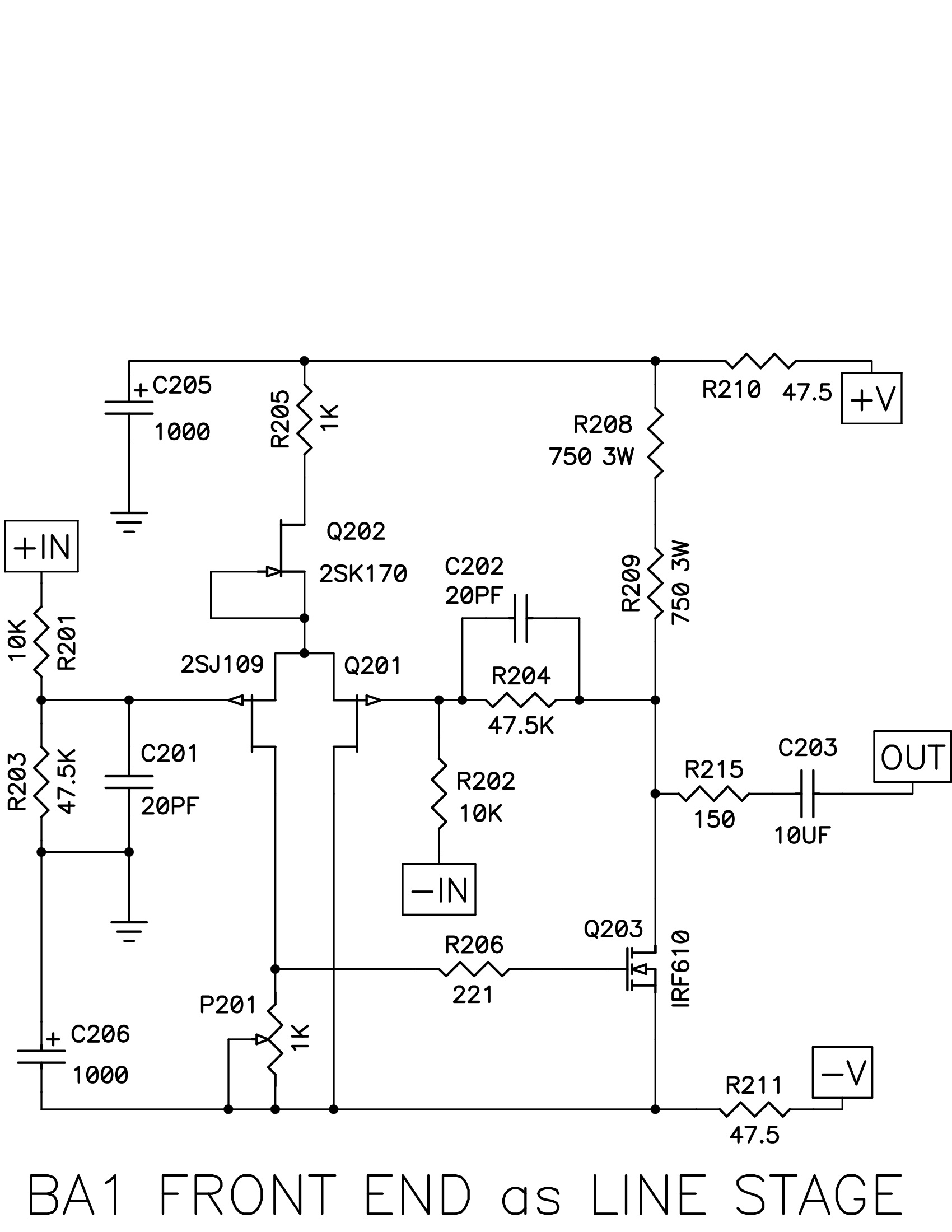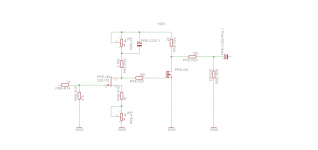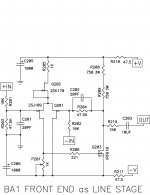It will probably end up with proper engineering as I have to be on the safe side on many parameters. Loss in transformer, voltage drop over bridge, loss in capacitors. It is interesting to play with this in Duncans PSU designer. A 25VAC on secondary trafo with low loss may work.
8 year member - first post. C3 specs 10uF. Can a 12uF be used?
Thanks,
Ken
that's nice; appears this is actually your fourth ... message
Last edited:
I've been wondering these days while i was making the layout for the BA3 FE(since i could not buy those ...shipping issues) for feeding a single ended BA3 output stage:
"Why use complementary when all i want is single ended from needle to speaker!?"
Do i have such an option/previous project in a non feedback approach?
I thought of just using the single ended approach with a 50-60V rail for the last stage mosfet.
Anyone has even considered this as diy?
"Why use complementary when all i want is single ended from needle to speaker!?"
Do i have such an option/previous project in a non feedback approach?
I thought of just using the single ended approach with a 50-60V rail for the last stage mosfet.
Anyone has even considered this as diy?
I've been wondering these days while i was making the layout for the BA3 FE(since i could not buy those ...shipping issues) for feeding a single ended BA3 output stage:
"Why use complementary when all i want is single ended from needle to speaker!?"
Do i have such an option/previous project in a non feedback approach?
I thought of just using the single ended approach with a 50-60V rail for the last stage mosfet.
Anyone has even considered this as diy?
https://www.passdiy.com/pdf/brideofzen.pdf
omg you replied faster than i attached
I figured smart things happened before me thinking them
omg you replied faster than i attached
I figured smart things happened before me thinking them
This one has feedback...but it's a nice circuit and may give you some inspiration:
Salas DCG3 preamp (line & headphone)
How about this...

The answers to the immediate questions will be;
Q202, about 8ma Idss
Q201, yes, of course you can use a matched pair of LSJ74B/2SK74BL
PSU +/-24v
The BA-1 front end PCB will work.
The answers to the immediate questions will be;
Q202, about 8ma Idss
Q201, yes, of course you can use a matched pair of LSJ74B/2SK74BL
PSU +/-24v
The BA-1 front end PCB will work.
Attachments
Last edited:
Thank you all for the sugestions; but the bride of zen is an absurdly good match for a BA3 SE output stage ... i am amazed by the simplicity and elegance of the approach ...why these were not paired up to become Ba3 i wonder?
Thank you all for the sugestions; but the bride of zen is an absurdly good match for a BA3 SE output stage ... i am amazed by the simplicity and elegance of the approach ...why these were not paired up to become Ba3 i wonder?
Low input impedance, high output impedance and only 15db gain. That's probably why.
Seconded
Nice. And you get balanced input for free.
To increase the unobtainium part count, one might replace the IRF610
with a 2sk2013.
Low input impedance, high output impedance and only 15db gain. That's probably why.
i am glad i thought about that ... wouldn't a nice stage with a 2sk170 bring easily 15 db gain and solve the input impeDANCE
and outputwise, using the prohibitively rare and properly biased 2sk2013's wouldn't solve the output impedance ... so all is left is the simulation and breadboard dance towards a functional solution?
i am glad i thought about that ... wouldn't a nice stage with a 2sk170 bring easily 15 db gain and solve the input impeDANCE?
and outputwise, using the prohibitively rare and properly biased 2sk2013's wouldn't solve the output impedance ... so all is left is the simulation and breadboard dance towards a functional solution?
Another circuit that you might like if you have not seen it already:
Jfet BOZ
I've spent the last couple of months stuffing Pearl 2 and BA-3 FE boards and I'm getting close to the point where I can start applying power to these bad boys.
My plan is to go with a two-chassis setup; one box for the trafos/PSUs and another for the Pearl 2 and BA-3 boards. Right now, I have an AN-1222 (100VA, 22+22) transformer that I plan to drop in to supply both the Pearl 2 and the BA-3: set up positive and negative busses so they'll feed the Pearl after rectification as well as an UltraBiB for the preamp. I might still run a pair of UltraBiBs knowing it won't be true dual-mono (running from one transformer) but I can always go back and rewire for that or get a second BA-3 for balanced if I want to go that route. I'm not worried about the VA rating; I know that's overkill for this application (it's what I have) but by my math, 22VAC will give me 29.7VDC and, from what I've read, the UltraBiB will eat the extra 5V giving me 24 for the BA-3. Any issues with running a single trafo for all of my pre-amplification needs?
Is there any real benefit to running the BA-3 in dual-mono or balanced? I know that's a heckuva loaded question; it's just that I intend to have a F4 and/or Aleph J completed by Christmas and they'll feed a pair of bookshelf speakers (Martin Logan 35XT, 92dB/4 Ohm) and a small subwoofer (Sunfire Super Junior). The 35XTs have four inputs (bi-amp capable), so I might eventually build four monoblocks for them. They're still bookshelf speakers, so I think anything beyond dual-mono would be for bragging rights/"because I can". Heck, maybe run a F4 for the top end and Aleph-J for the lower frequencies? I'm not sure what the topography would look like for that setup but it sounds like balanced to me.
My plan is to go with a two-chassis setup; one box for the trafos/PSUs and another for the Pearl 2 and BA-3 boards. Right now, I have an AN-1222 (100VA, 22+22) transformer that I plan to drop in to supply both the Pearl 2 and the BA-3: set up positive and negative busses so they'll feed the Pearl after rectification as well as an UltraBiB for the preamp. I might still run a pair of UltraBiBs knowing it won't be true dual-mono (running from one transformer) but I can always go back and rewire for that or get a second BA-3 for balanced if I want to go that route. I'm not worried about the VA rating; I know that's overkill for this application (it's what I have) but by my math, 22VAC will give me 29.7VDC and, from what I've read, the UltraBiB will eat the extra 5V giving me 24 for the BA-3. Any issues with running a single trafo for all of my pre-amplification needs?
Is there any real benefit to running the BA-3 in dual-mono or balanced? I know that's a heckuva loaded question; it's just that I intend to have a F4 and/or Aleph J completed by Christmas and they'll feed a pair of bookshelf speakers (Martin Logan 35XT, 92dB/4 Ohm) and a small subwoofer (Sunfire Super Junior). The 35XTs have four inputs (bi-amp capable), so I might eventually build four monoblocks for them. They're still bookshelf speakers, so I think anything beyond dual-mono would be for bragging rights/"because I can". Heck, maybe run a F4 for the top end and Aleph-J for the lower frequencies? I'm not sure what the topography would look like for that setup but it sounds like balanced to me.
Hello, I wish I found this site years ago! Awesome discussions and builds. My first post...
I'm sorting through posts on line stages and have focused in on the BBA-03 (though the Iron Pumpkin looks interesting).
This will be my first build with an intent to move on to a pair of mono-blocks (Aleph X though the SizzySIT could be fun) and latter a Pearl 2.
Last week I ordered a pair of the BA-3 gain stage PCBs and matched set of JFets from the DIYAudio store. My plan is for a dual mono build with 2nd chassis for the PSU. I did order the universal PS board as well, though I'm thinking about the superreg board.
Still need to sort out PSU and also about getting matched pairs of MOSFETs, hopefully the 2SK2013/2SJ313.
Currently my thought is to purchase a pair of Tortuga LDR controllers & displays with a total of 6 balanced & SE inputs / 2 balanced out with a single remote. Not cheap but Tortuga has what I'm looking for.
I do not need a RCA output. Does this allow me to eliminate the coupling output capacitor?
Any additional suggestions/guidance would be appreciated!
Thanks
Rob
I'm sorting through posts on line stages and have focused in on the BBA-03 (though the Iron Pumpkin looks interesting).
This will be my first build with an intent to move on to a pair of mono-blocks (Aleph X though the SizzySIT could be fun) and latter a Pearl 2.
Last week I ordered a pair of the BA-3 gain stage PCBs and matched set of JFets from the DIYAudio store. My plan is for a dual mono build with 2nd chassis for the PSU. I did order the universal PS board as well, though I'm thinking about the superreg board.
Still need to sort out PSU and also about getting matched pairs of MOSFETs, hopefully the 2SK2013/2SJ313.
Currently my thought is to purchase a pair of Tortuga LDR controllers & displays with a total of 6 balanced & SE inputs / 2 balanced out with a single remote. Not cheap but Tortuga has what I'm looking for.
I do not need a RCA output. Does this allow me to eliminate the coupling output capacitor?
Any additional suggestions/guidance would be appreciated!
Thanks
Rob
I think the BA-3 pre was made for power amps with low gain. I used it for MoFo where it worked very well.
I you decide to go with Fairchild outputs (I did) remember to use…..I think 500R instead of 1k trimmers for P1, P2 (not 100% sure of the values).
If you can live with a bit of DC at the output (especially during warm up) it should be ok to leave out the output caps.
A good idea to measure P3 prior to insert it and set it to mid point.
If you later decide to play with P3 setting then remember to adjust P1, P2 again (to have correct bias and offset after P3 adjust).
I you decide to go with Fairchild outputs (I did) remember to use…..I think 500R instead of 1k trimmers for P1, P2 (not 100% sure of the values).
If you can live with a bit of DC at the output (especially during warm up) it should be ok to leave out the output caps.
A good idea to measure P3 prior to insert it and set it to mid point.
If you later decide to play with P3 setting then remember to adjust P1, P2 again (to have correct bias and offset after P3 adjust).
- Home
- Amplifiers
- Pass Labs
- BA-3 As Preamp

